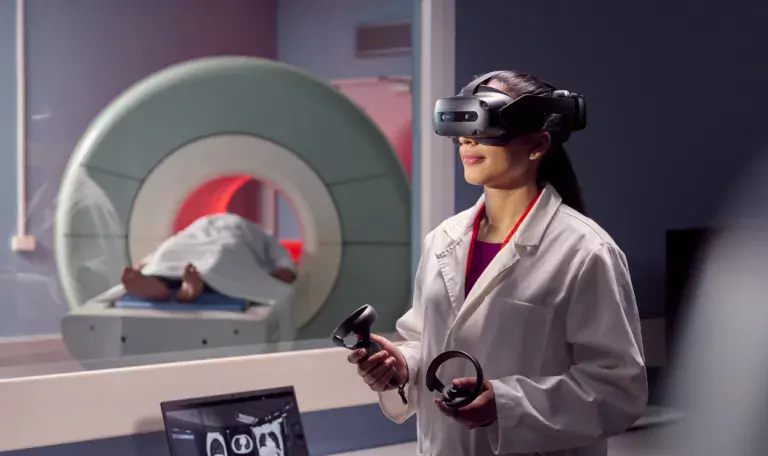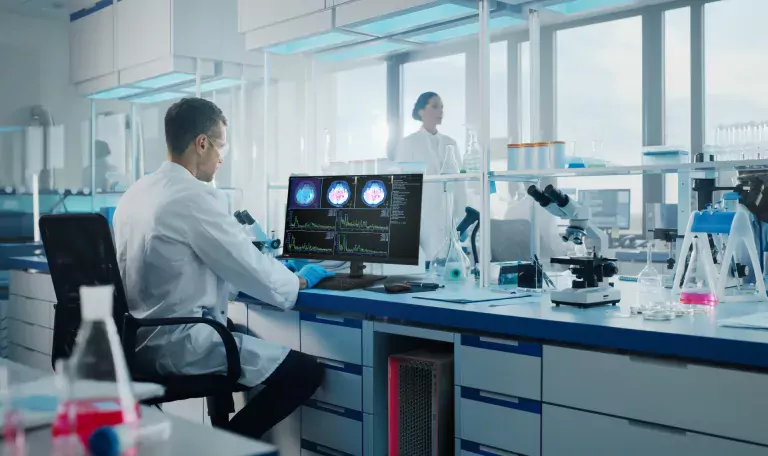Technology helps serve communities better.
The public health emergency for COVID-19 is set to expire May 11, 2023.1 But the changes for health and human services (HHS) agencies at the state and local level brought about by the pandemic will endure long past that date.
Some of these changes — in the populations HHS agencies serve, the environments in which they work, and the ways they fulfill their missions — were sudden, while others simply accelerated trends already in motion. Now, as we approach the nominal end of the pandemic, these changes represent both challenges and opportunities.
This article will review some of the challenges today’s state and local HHS agencies face and demonstrate how, with the help of technology, their response to the challenges can create opportunities to serve communities better.
Solving the labor shortage challenge in state and local HHS.
Perhaps the most widely recognized aftereffect of the pandemic is the nationwide shortage of talent in both the private and public sectors. The “Great Retirement” (or “Silver Tsunami”) has cost the U.S. public sector a significant portion of its talent pool:
- In December 2022, there were 452,000 fewer workers in the public sector than before the pandemic.2
- State and local employment is more than 5% below February 2020 levels in many states.3
- Of those surveyed, 69% of state and local government human resources professionals say more employees are quitting, and 60% say more employees are retiring.4
HHS departments in many communities continue to experience shortages even more severe. For instance, the city of New York’s Department of Health and Mental Hygiene had nearly 1,200 unfilled positions in June 2022 — a 19% vacancy rate.5
These shortages are likely to persist. The challenge for state and local HHS agencies is to create an environment that’s more attractive for today’s workforce, both to retain current employees in their jobs and attract the next generation of public health and human and services workers.
A potential solution to this challenge lies in a trend that accelerated rapidly during the pandemic: hybrid work. Research shows that 87% of people across demographics, occupations, and geographies welcome the chance to work flexibly, and 58% of Americans report having the opportunity to work from home at least one day a week.6
To retain and attract talent, state and local HHS agencies must enable the flexible, hybrid work styles that people prefer, and that will require them to procure the technology that makes those work styles possible. Putting those solutions at their disposal can lead to greater job satisfaction for current employees and help attract workers who make flexibility a high priority when seeking new jobs.
Deliver technology caseworkers want.
Lenovo solutions like the ThinkPad X13 Gen 4, featuring Intel vPro®, An Intel® Evo™ Design with 13th Gen Intel® Core™ i7 processors are built for what IT needs and users want. All running Windows 11 Pro and enhanced with Microsoft Teams to give the next generation of caseworkers greater flexibility and more productive collaboration.
Digital transformation extends agencies’ reach and effectiveness.
The COVID pandemic created new challenges — and exacerbated others — for communities served by state and local HHS agencies, and these challenges are likely to persist long after the official end of the public health emergency.
Technology gives HHS agencies the means to address these challenges by expanding employees’ reach and effectiveness. However, leaders recognize that implementing new technology is rarely a simple matter, and that they can only attain real gains in efficiency and quality of service by grounding their investments in an organization-wide vision.
This approach to digital transformation can be seen in a few recent examples:8
The Oklahoma Department of Human Services redesigned their eligibility determination process from all in-person screening to 100% virtual, enabling them to move hundreds of back-office staff to the front line — where they can build deeper relationships with the people they serve in homeless shelters, food banks, and prisons. Meanwhile, they’ve embedded their technology team into program teams to ensure IT investments mesh with frontline priorities.
In Idaho, the Department of Health and Welfare focuses on what processes need to improve, identifies solutions, and uncovers early wins. This paradigm shift helped them realize that inefficiencies in their benefits eligibility process had more to do with front-end processes than back-end eligibility determination. Replacing a paper application with an informed choice interview — and ensuring staffers had the technology to quickly review eligibility criteria — helped Idaho gain top five status in the nation for accuracy and number one for timeliness.
The Michigan Department of Health and Human Services has embraced human-centered design in its MI Bridges system that helps clients without readily available technology access Medicaid, SNAP, TANF, LIHEAP, and childcare. This approach incorporates the voice of lived experience, engagement by developers and testers with frontline staff at state and local offices, and cross-programmatic service delivery models to maximize the return on the state’s technology investments — and earn an 80-95% approval rating from users.
These examples demonstrate the importance of making IT investment decisions as part of a holistic view of an agency’s environment, clientele, and mission. State and local HHS agencies facing the changes and challenges of the post-COVID era can’t make technology decisions in a vacuum. They need a vision, and a technology partner willing to work within that vision, to leverage advanced technology into improved efficiency and better services for their communities.
Taking cybersecurity threats more seriously than ever.
Cyberattacks on state and local governments did not abate during the pandemic. In fact, cybercriminals have become more sophisticated, targeting legacy, on-premise servers and software with ever-evolving attacks. These attacks significantly impair agency budgets; in fact, the average public sector cybersecurity incident costs government agencies more than $2 million.8
The most common cyberattacks against government agencies are phishing emails, along with exploitation of remote desktop protocols and software vulnerabilities. The FBI also points to new, more dangerous actions including using service-for-hire business models, sharing victim information among actor groups, using more diverse extortion strategies, and attacking access and data sources such as cloud infrastructure, managed service providers, and software supply chains.8
Fortunately, state and local government officials recognize the danger of these threats — 95% consider long-term resilience and risk protection important.9 State and local HHS agencies capture and share people’s most sensitive information, and security risks rise as more of their workforce works remotely or in a hybrid workstyle. These factors make it especially crucial that agencies follow comprehensive security protocols — and find trusted partners who can help them effectively and securely manage client data.
At Lenovo, security is an integral part of everything we do. Lenovo ThinkShield solutions — powered by Windows 11 Pro and Intel vPro® — combine real-world responsiveness with ironclad security and optimized performance from endpoint to cloud.
A trusted technology partner for government
Every HHS agency has a vision for delivering the best services for their communities. The right technology and the right technology partner can help make that vision a reality.
More than 900 U.S. state and local agencies and 70 military and civilian federal agencies trust Lenovo to deliver secure, high-performance solutions and expertise for the unique challenges facing government IT professionals. Many Lenovo solutions feature Intel vPro®, An Intel® Evo™ Design, which supports hardware-based secure PC technology and secure endpoints. For dynamic collaboration, Lenovo solutions also feature Microsoft Teams and Windows 11.
And Lenovo offers far more than the latest technology. Our service is unparalleled, including essential help desk support for remote workers. We also hold multiple certifications from the U.S. government, highlighting our ongoing relationship as a trusted partner at the federal, state, and local levels:
- Current GSA contract/permission to sell PC workstations to U.S. federal agencies
- TAA-compliant manufacturing ability in Mexico and Hungary
- Tier III Certification representing the U.S. Customs and Border Protection’s highest-rated C-TPAT certification level
- MIL-SPEC Certified technology to ensure durability with hundreds of quality checks
To transform the challenges of the post-COVID era into opportunities to serve your communities better and more efficiently, learn more about Lenovo for Government or contact your Lenovo for Government representative.






